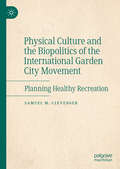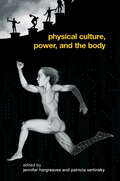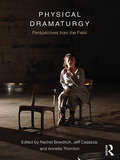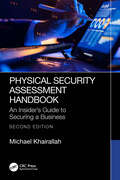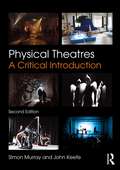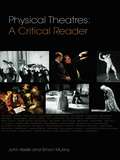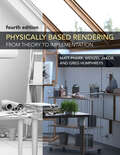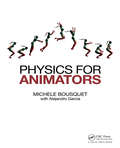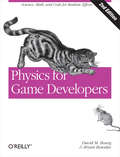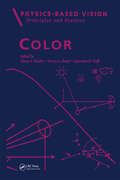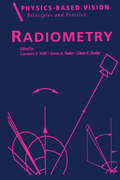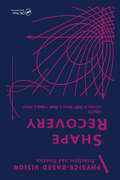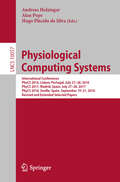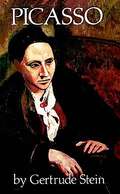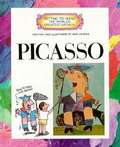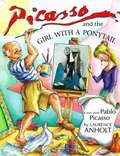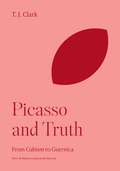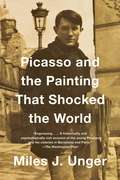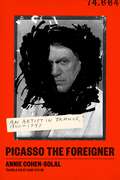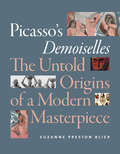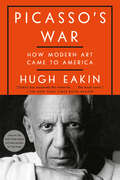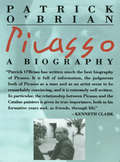- Table View
- List View
Physical Culture and the Biopolitics of the International Garden City Movement: Planning Healthy Recreation
by Samuel M. ClevengerThis book revisits the history of the international garden city town planning movement in the early twentieth century, focusing on the significance of various forms of 'physical culture' - sport, recreation, leisure, and other active body practices - within garden city planning discourse and the development of some of the first garden city communities in the United Kingdom and United States.
Physical Culture, Power, and the Body (Routledge Critical Studies in Sport)
by Patricia Vertinsky Jennifer HargreavesDuring the past decade, there has been an outpouring of books on 'the body' in society, but none has focused as specifically on physical culture - that is, cultural practices such as sport and dance within which the moving physical body is central. Questions are raised about the character of the body, specifically the relation between the ‘natural’ body, the ‘constructed’ body and the ‘alien’ or ‘virtual’ body. The themes of the book are wide in scope, including: physical culture and the fascist body sport and the racialised body sport medicine, health and the culture of risk the female Muslim sporting body, power, and politics experiencing the disabled sporting body embodied exhibitions of striptease and sport the social logic of sparring sport, girls and the neoliberal body. Physical Culture, Power, and the Body aims to break down disciplinary boundaries in its theoretical approaches and its readership. The author’s muli-disciplinary backgrounds, demonstrate the widespread topicality of physical culture and the body.
Physical Dramaturgy: Perspectives from the Field
by Rachel Bowditch Jeff Casazza Annette ThorntonWhat is physical dramaturgy? While the traditional dramaturg shares research intellectually, the physical dramaturg does so viscerally and somatically. By combining elements of text, history, dramatic structure, and the author’s intent with movement analysis and physical theatre pedagogies, the physical dramaturg gives actors the opportunity to manifest their work in a connected and intuitive manner and creates a field that is as varied and rich as the theatre itself. Physical Dramaturgy: Perspectives from the Field explores the ways in which this unique role can benefit the production team during the design and rehearsal phases of both traditional and devised productions. Individual chapters look at new ways of approaching a wealth of physical worlds, from the works of Shakespeare and other period playwrights to the processes of Jerzy Grotowski, Lloyd Williamson, Richard Schechner, and Michael Chekhov, and devising original works in a variety of contexts from Pig Iron, Dell’Arte International, Bill Bowers and mime, Tectonic Theater Project, and Liz Lerman’s Dance Exchange. This anthology gives dramaturgs, actors, and directors new ways of looking at existing methods and provides examples of how to translate, combine, and adapt them into new explorations for training, rehearsal, or research.
Physical Security Assessment Handbook: An Insider’s Guide to Securing a Business
by Michael KhairallahPhysical Security Assessment Handbook: An Insider’s Guide to Securing a Business, Second Edition has been fully updated to help you identify threats to your organization and be able to mitigate such threats. The techniques in this comprehensive book outline a step-by-step approach to: Identify threats to your assets Assess physical security vulnerabilities Design systems and processes that mitigate the threats Set a budget for your project and present it to company managers Acquire the products through competitive bidding Implement the recommended solutions Each chapter walks you through a step in the assessment process, providing valuable insight and guidance. There are illustrations and checklists that help simplify the process and ensure that the right course is taken to secure your company. This book provides seasoned advice on the competitive bidding process as well as legal issues involved in facility security. After reading it, you will know how to assess your security needs, specify the right products, and oversee and manage the project and installation. It concludes with project implementation, and the necessary follow-up after installation, to verify the proper use of the new security solutions. Physical Security Assessment Handbook, Second Edition provides a structure for best practices in both specifying system components as well as managing the acquisition and implementation process. It represents the culmination of the author’s 44 years of experience in the design, installation, and project management of security system solutions. This is a valuable resource for security managers, security consultants, and even experienced industry professionals to best approach and organize security assessment projects.
Physical Theatres: A Critical Introduction
by Simon Murray John KeefeThis new edition of Physical Theatres: A Critical Introduction continues to provide an unparalleled overview of non-text-based theatre, from experimental dance to traditional mime. It synthesizes the history, theory and practice of physical theatres for students and performers in what is both a core area of study and a dynamic and innovative aspect of theatrical practice. This comprehensive book: traces the roots of physical performance in classical and popular theatrical traditions looks at the Dance Theatre of DV8, Pina Bausch, Liz Aggiss and Jérôme Bel examines the contemporary practice of companies such as Théatre du Soleil, Complicite and Goat Island focuses on principles and practices in actor training, with reference to figures such as Jacques Lecoq, Lev Dodin, Philippe Gaulier, Monika Pagneux, Etienne Decroux, Anne Bogart and Joan Littlewood. Extensive cross references ensure that Physical Theatres: A Critical Introduction can be used as a standalone text or together with its companion volume, Physical Theatres: A Critical Reader, to provide an invaluable introduction to the physical in theatre and performance. New to this edition: a chapter on The Body and Technology, exploring the impact of digital technologies on the portrayal, perception and reading of the theatre body, spanning from onstage technology to virtual realities and motion capture; additional profiles of Jerzy Grotowski, Wrights and Sites, Punchdrunk and Mike Pearson; focus on circus and aerial performance, new training practices, immersive and site-specific theatres, and the latest developments in neuroscience, especially as these impact on the place and role of the spectator.
Physical Theatres: A Critical Reader
by Simon Murray John KeefePhysical Theatres: A Critical Reader is an invaluable resource for students of physically orientated theatre and performance. This book aims to trace the roots and development of physicality in theatre by combining practical experience of the field with a strong historical and theoretical underpinning. In exploring the histories, cross-overs and intersections of physical theatres, this critical Reader provides: six new, specially commissioned essays, covering each of the book’s main themes, from technical traditions to contemporary practises discussion of issues such as the foregrounding of the body, training and performance processes, and the origins of theatre in both play and human cognition a focus on the relationship and tensions between the verbal and the physical in theatre contributions from Augusto Boal, Stephen Berkoff, Étienne Decroux, Bertolt Brecht, David George, J-J. Rousseau, Ana Sanchez Colberg, Michael Chekhov, Jeff Nuttall, Jacques Lecoq, Yoshi Oida, Mike Pearson, and Aristotle.
Physically Based Rendering, fourth edition: From Theory to Implementation
by Matt Pharr Greg Humphreys Wenzel JakobA comprehensive update of the leading-edge computer graphics textbook that sets the standard for physically-based rendering in the industry and the field, with new material on GPU ray tracing.Photorealistic computer graphics are ubiquitous in today&’s world, widely used in movies and video games as well as product design and architecture. Physically-based approaches to rendering, where an accurate modeling of the physics of light scattering is at the heart of image synthesis, offer both visual realism and predictability. Now in a comprehensively updated new edition, this best-selling computer graphics textbook sets the standard for physically-based rendering in the industry and the field. Physically Based Rendering describes both the mathematical theory behind a modern photorealistic rendering system as well as its practical implementation. A method known as literate programming combines human-readable documentation and source code into a single reference that is specifically designed to aid comprehension. The book&’s leading-edge algorithms, software, and ideas—including new material on GPU ray tracing—equip the reader to design and employ a full-featured rendering system capable of creating stunning imagery. This essential text represents the future of real-time graphics. Detailed and rigorous but accessible approach guides readers all the way from theory to practical software implementationFourth edition features new chapter on GPU ray tracing essential for game developersThe premier reference for professionals learning about and working in the fieldWon its authors a 2014 Academy Award for Scientific and Technical Achievement Includes a companion site complete with source code
Physics and Dance
by Emily Coates Sarah DemersA fascinating exploration of our reality through the eyes of a physicist and a dancer—and an engaging introduction to both disciplines From stepping out of our beds each morning to admiring the stars at night, we live in a world of motion, energy, space, and time. How do we understand the phenomena that shape our experience? How do we make sense of our physical realities? Two guides—a former member of New York City Ballet, Emily Coates, and a CERN particle physicist, Sarah Demers—show us how their respective disciplines can help us to understand both the quotidian and the deepest questions about the universe. Requiring no previous knowledge of dance or physics, this introduction covers the fundamentals while revealing how a dialogue between art and science can enrich our appreciation of both. Readers will come away with a broad cultural knowledge of Newtonian to quantum mechanics and classical to contemporary dance. Including problem sets and choreographic exercises to solidify understanding, this book will be of interest to anyone curious about physics or dance.
Physics for Animators
by Michele BousquetAchieving believable motion in animation requires an understanding of physics that most of us missed out on in art school. Although animators often break the laws of physics for comedic or dramatic effect, you need to know which laws you’re breaking in order to make it work. And while large studios might be able to spend a lot of time and money testing different approaches or hiring a physics consultant, smaller studios and independent animators have no such luxury. This book takes the mystery out of physics tasks like character motion, light and shadow placement, explosions, ocean movement, and outer space scenes, making it easy to apply realistic physics to your work. <li>Physics concepts are explained in animator’s terms, relating concepts specifically to animation movement and appearance. <li>Complex mathematical concepts are broken down into clear steps you can follow to solve animation problems quickly and effectively. <li>Bonus companion website at www.physicsforanimators.com offers additional resources, including examples in movies and games, links to resources, and tips on using physics in your work. <P><P>Uniting theory and practice, author Michele Bousquet teaches animators how to swiftly and efficiently create scientifically accurate scenes and fix problem spots, and how and when to break the laws of physics. Ideal for everything from classical 2D animation to advanced CG special effects, this book provides animators with solutions that are simple, quick, and powerful.
Physics for Game Developers: Science, math, and code for realistic effects
by David M Bourg Bryan BywalecIf you want to enrich your game’s experience with physics-based realism, the expanded edition of this classic book details physics principles applicable to game development. You’ll learn about collisions, explosions, sound, projectiles, and other effects used in games on Wii, PlayStation, Xbox, smartphones, and tablets. You’ll also get a handle on how to take advantage of various sensors such as accelerometers and optical tracking devices.Authors David Bourg and Bryan Bywalec show you how to develop your own solutions to a variety of problems by providing technical background, formulas, and a few code examples. This updated book is indispensable whether you work alone or as part of a team.Refresh your knowledge of classical mechanics, including kinematics, force, kinetics, and collision responseExplore rigid body dynamics, using real-time 2D and 3D simulations to handle rotation and inertiaApply concepts to real-world problems: model the behavior of boats, airplanes, cars, and sports ballsEnhance your games with digital physics, using accelerometers, touch screens, GPS, optical tracking devices, and 3D displaysCapture 3D sound effects with the OpenAL audio API
Physics-Based Vision: Color, Volume 2
by Glenn E. Healey Steven A. Shafer Lawrence B. WolffCommentaries by the editors to this comprehensive anthology in the area of physics-based vision put the papers in perspective and guide the reader to a thorough understanding of the basics of the field. Paper Topics Include: - Color Image Formation - Color Reflection Models - Color Image Segmentation - Color Constancy - Color Highlight Analysis - C
Physics-Based Vision: Radiometry, Volume 1
by Glenn E. Healey Steven A. Shafer Lawrence B. WolffCommentaries by the editors to this comprehensive anthology in the area of physics-based vision put the papers in perspective and guide the reader to a thorough understanding of the basics of the field. Paper Topics Include: - Intensity Reflection Models - Polarization and Refraction - Camera Calibration - Quantization and Sampling - Depth from Opt
Physics-Based Vision: Shape Recovery, Volume 3
by Glenn E. Healey Steven A. Shafer Lawrence B. WolffCommentaries by the editors to this comprehensive anthology in the area of physics-based vision put the papers in perspective and guide the reader to a thorough understanding of the basics of the field. Paper Topics Include: - Shape from Shading - Photometric Stereo - Shape Recovery from Specular Reflection - Shape Recovery from Interreflection - Shape Recovery from Shadows - Radiometric Analysis of Stereo and Motion - Physics-Based Sensor Fusion.
Physiological Computing Systems: International Conferences, PhyCS 2016, Lisbon, Portugal, July 27–28, 2016, PhyCS 2017, Madrid, Spain, July 27–28, 2017, PhyCS 2018, Seville, Spain, September 19–21, 2018, Revised and Extended Selected Papers (Lecture Notes in Computer Science #10057)
by Andreas Holzinger Hugo Plácido da Silva Alan PopeThis book constitutes the proceedings of the Third International Conference on Physiological Computing Systems, PhyCS 2016, held in Lisbon, Portugal, in July 2016.The 12 papers presented in this volume were carefully reviewed and selected from numerous submissions. They contribute to the understanding of relevant trends of current research on physiological computing systems, including brain-computer interfaces, virtual reality, psychophysiological load assessment in unconstrained scenarios, body tracking and movement pattern recognition, emotion recognition, machine learning applied to diabetes and hypertension, tangible biofeedback technologies, multimodal sensor data fusion, and deep learning for hand gesture recognition.
Picasso
by Gertrude SteinFor more than a generation, Gertrude Stein's Paris home at 27 rue de Fleurus was the center of a glittering coterie of artists and writers, one of whom was Pablo Picasso. In this intimate and revealing memoir, Stein tells us much about the great man (and herself) and offers many insights into the life and art of the 20th century's greatest painter.Mixing biological fact with artistic and aesthetic comments, she limns a unique portrait of Picasso as a founder of Cubism, an intimate of Appollinaire, Max Jacob, Braque, Derain, and others, and a genius driven by a ceaseless quest to convey his vision of the 20th century. We learn, for example, of the importance of his native Spain in shaping Picasso's approach to art; of the influence of calligraphy and African sculpture; of his profound struggle to remain true to his own vision; of the overriding need to empty himself of the forms and ideas that welled up within him.Stein's close relationship with Picasso furnishes her with a unique vantage point in composing this perceptive and provocative reminiscence. It will delight any admirer of Picasso or Gertrude Stein; it is indispensable to an understanding of modern art.
Picasso (Getting to Know the World's Greatest Artists)
by Mike VeneziaBriefly examines the life and work of the renowned twentieth-century artist, describing and giving examples from his various periods or styles.
Picasso And The Girl With A Ponytail: A Story About Pablo Picasso
by Laurence AnholtHere is the fascinating story -- based on true fact -- of a world-famous artist and a little girl who became one of his models. Sylvette first met Picasso in 1954, when she was a girl in the southern French town of Vallauris.<P><P> At that time, she was the shyest and dreamiest girl among her friends, though today, she is a respected artist in her own right. When Picasso set up his studio in a nearby house, he spotted young Sylvette and was taken immediately by her classical profile and her lovely ponytail. <P> When at last he convinced her to pose for what became the first of more than forty works of art, the two gradually became good friends. Before long, Picasso's portraits of Sylvette became famous around the world.
Picasso and Truth: From Cubism to Guernica (The A. W. Mellon Lectures in the Fine Arts #58)
by T. J. ClarkA groundbreaking reassessment of Picasso by one of today's preeminent art historiansPicasso and Truth offers a breathtaking and original new look at the most significant artist of the modern era. From Pablo Picasso's early The Blue Room to the later Guernica, eminent art historian T. J. Clark offers a striking reassessment of the artist's paintings from the 1920s and 1930s. Why was the space of a room so basic to Picasso's worldview? And what happened to his art when he began to feel that room-space become too confined—too little exposed to the catastrophes of the twentieth century? Clark explores the role of space and the interior, and the battle between intimacy and monstrosity, in Picasso's art. Based on the A. W. Mellon Lectures in the Fine Arts delivered at the National Gallery of Art, this volume remedies the biographical and idolatrous tendencies of most studies on Picasso, reasserting the structure and substance of the artist's work.With compelling insight, Clark focuses on three central works—the large-scale Guitar and Mandolin on a Table (1924), The Three Dancers (1925), and The Painter and His Model (1927)—and explores Picasso's answer to Nietzsche's belief that the age-old commitment to truth was imploding in modern European culture. Masterful in its historical contextualization, Picasso and Truth rescues Picasso from the celebrity culture that trivializes his accomplishments and returns us to the tragic vision of his art—humane and appalling, naïve and difficult, in mourning for a lost nineteenth century, yet utterly exposed to the hell of Europe between the wars.Published in association with the Center for Advanced Study in the Visual Arts, National Gallery of Art, Washington, DCPlease note: All images in this ebook are presented in black and white and have been reduced in size.
Picasso and the Painting That Shocked the World
by Miles J. UngerOne of The Christian Science Monitor&’s Best Nonfiction Books of 2018 &“An engrossing read…a historically and psychologically rich account of the young Picasso and his coteries in Barcelona and Paris&” (The Washington Post) and how he achieved his breakthrough and revolutionized modern art through his masterpiece, Les Demoiselles d&’Avignon.In 1900, eighteen-year-old Pablo Picasso journeyed from Barcelona to Paris, the glittering capital of the art world. For the next several years he endured poverty and neglect before emerging as the leader of a bohemian band of painters, sculptors, and poets. Here he met his first true love and enjoyed his first taste of fame. Decades later Picasso would look back on these years as the happiest of his long life. Recognition came first from the avant-garde, then from daring collectors like Leo and Gertrude Stein. In 1907, Picasso began the vast, disturbing masterpiece known as Les Demoiselles d&’Avignon. Inspired by the painting of Paul Cézanne and the inventions of African and tribal sculpture, Picasso created a work that captured the disorienting experience of modernity itself. The painting proved so shocking that even his friends assumed he&’d gone mad, but over the months and years it exerted an ever greater fascination on the most advanced painters and sculptors, ultimately laying the foundation for the most innovative century in the history of art. In Picasso and the Painting That Shocked the World, Miles J. Unger &“combines the personal story of Picasso&’s early years in Paris—his friendships, his romances, his great ambition, his fears—with the larger story of modernism and the avant-garde&” (The Christian Science Monitor). This is the story of an artistic genius with a singular creative gift. It is &“riveting…This engrossing book chronicles with precision and enthusiasm a painting with lasting impact in today&’s art world&” (Publishers Weekly, starred review), all of it played out against the backdrop of the world&’s most captivating city.
Picasso the Foreigner: An Artist in France, 1900-1973
by Annie Cohen-Solal"Absorbing [and] astute . . . Cohen-Solal captures a facet of Picasso’s character long overlooked." —Hamilton Cain, The Wall Street Journal"A beguiling read, as ingenious as it is ambitious . . . See Picasso and Paris shimmering with new light." —Mark Braude, author of Kiki Man Ray: Art, Love, and Rivalry in 1920s ParisBorn from her probing inquiry into Picasso's odyssey in France, which inspired a museum exhibition of the same name, historian Annie-Cohen Solal’s Picasso the Foreigner presents a bold new understanding of the artist’s career and his relationship with the country he called home.Winner of the 2021 Prix Femina EssaiBefore Picasso became Picasso—the iconic artist now celebrated as one of France’s leading figures—he was constantly surveilled by the police. Amidst political tensions in the spring of 1901, he was flagged as an anarchist by the security services—the first of many entries in what would become an extensive case file. Though he soon became the leader of the cubist avant-garde, and became increasingly wealthy as his reputation grew worldwide, Picasso’s art was largely excluded from public collections in France for the next four decades. The genius who conceived Guernica as a visceral statement against fascism in 1937 was even denied French citizenship three years later, on the eve of the Nazi occupation. In a country where the police and the conservative Académie des Beaux-Arts represented two major pillars of the establishment at the time, Picasso faced a triple stigma—as a foreigner, a political radical, and an avant-garde artist.Picasso the Foreigner approaches the artist’s career and work from an entirely new angle, making extensive use of fascinating and long-understudied archival sources. In this groundbreaking narrative, Picasso emerges as an artist ahead of his time not only aesthetically but politically, one who ignored national modes in favor of contemporary cosmopolitan forms. Cohen-Solal reveals how, in a period encompassing the brutality of World War I, the Nazi occupation, and Cold War rivalries, Picasso strategized and fought to preserve his agency, eventually leaving Paris for good in 1955. He chose the south over the north, the provinces over the capital, and craftspeople over academicians, while simultaneously achieving widespread fame. The artist never became a citizen of France, yet he enriched and dynamized its culture like few other figures in the country’s history. This book, for the first time, explains how.Includes color images
Picasso's Brain: The basis of creative genius
by Christine TempleWhere does creativity come from? Why are some people more creative than others?Eminent neuropsychologist Christine Temple navigates a wide range of factors from the hard science (visual memory, spatial ability, brain functions) to the environmental (the 'mad genius' myth, and Gladwell's 10,000 hours of practice) in her study of what contributes to creativity. Using Pablo Picasso as her model of a creative genius, she weighs up each theory as it applies to Picasso and shows how his own creativity came from a combination of many factors.In this book, she looks at Picasso's playful mindset and passionate relationships, investigates the possibility that genius is genetic and can be inherited in families, considers whether creative genii perceive the world in a different way, and determines whether single-mindedness and focus play a part. This is the first book to look at a multitude of traits in creativity, and nail down the key factors that matter (and also which ones don't) to provide an overall picture of this fascinating area, linking the science to the personal.
Picasso's Brain: The basis of creative genius
by Christine TempleWhere does creativity come from? Why are some people more creative than others?Eminent neuropsychologist Christine Temple navigates a wide range of factors from the hard science (visual memory, spatial ability, brain functions) to the environmental (the 'mad genius' myth, and Gladwell's 10,000 hours of practice) in her study of what contributes to creativity. Using Pablo Picasso as her model of a creative genius, she weighs up each theory as it applies to Picasso and shows how his own creativity came from a combination of many factors.In this book, she looks at Picasso's playful mindset and passionate relationships, investigates the possibility that genius is genetic and can be inherited in families, considers whether creative genii perceive the world in a different way, and determines whether single-mindedness and focus play a part. This is the first book to look at a multitude of traits in creativity, and nail down the key factors that matter (and also which ones don't) to provide an overall picture of this fascinating area, linking the science to the personal.
Picasso's Demoiselles: The Untold Origins of a Modern Masterpiece
by Suzanne Preston BlierIn Picasso's Demoiselles, eminent art historian Suzanne Preston Blier uncovers the previously unknown history of Pablo Picasso's Les Demoiselles d&’Avignon, one of the twentieth century's most important, celebrated, and studied paintings. Drawing on her expertise in African art and newly discovered sources, Blier reads the painting not as a simple bordello scene but as Picasso's interpretation of the diversity of representations of women from around the world that he encountered in photographs and sculptures. These representations are central to understanding the painting's creation and help identify the demoiselles as global figures, mothers, grandmothers, lovers, and sisters, as well as part of the colonial world Picasso inhabited. Simply put, Blier fundamentally transforms what we know about this revolutionary and iconic work.
Picasso's War: How Modern Art Came to America
by Hugh EakinA riveting story of how dueling ambitions and the power of prodigy made America the cultural center of the world—and Picasso the most famous artist alive—in the shadow of World War II&“[Eakin] has mastered this material. . . . The book soars.&”—The New York Times Book Review (Editors&’ Choice)ONE OF THE BEST BOOKS OF THE YEAR: Vanity Fair, The New York Times Book Review, The New YorkerIn January 1939, Pablo Picasso was renowned in Europe but disdained by many in the United States. One year later, Americans across the country were clamoring to see his art. How did the controversial leader of the Paris avant-garde break through to the heart of American culture?The answer begins a generation earlier, when a renegade Irish American lawyer named John Quinn set out to build the greatest collection of Picassos in existence. His dream of a museum to house them died with him, until it was rediscovered by Alfred H. Barr, Jr., a cultural visionary who, at the age of twenty-seven, became the director of New York&’s new Museum of Modern Art.Barr and Quinn&’s shared goal would be thwarted in the years to come—by popular hostility, by the Depression, by Parisian intrigues, and by Picasso himself. It would take Hitler&’s campaign against Jews and modern art, and Barr&’s fraught alliance with Paul Rosenberg, Picasso&’s persecuted dealer, to get Picasso&’s most important paintings out of Europe. Mounted in the shadow of war, the groundbreaking exhibition Picasso: Forty Years of His Art would launch Picasso in America, define MoMA as we know it, and shift the focus of the art world from Paris to New York.Picasso&’s War is the never-before-told story about how a single exhibition, a decade in the making, irrevocably changed American taste, and in doing so saved dozens of the twentieth century&’s most enduring artworks from the Nazis. Through a deft combination of new scholarship and vivid storytelling, Hugh Eakin shows how two men and their obsession with Picasso changed the art world forever.
Picasso: A Biography
by Patrick O'Brian"The best biography of Picasso."--Kenneth Clark Patrick O'Brian's outstanding biography of Picasso is here available in paperback for the first time. It is the most comprehensive yet written, and the only biography fully to appreciate the distinctly Mediterranean origins of Picasso's character and art. Everything about Picasso, except his physical stature, was on an enormous scale. No painter of the first rank has been so awe-inspiringly productive. No painter of any rank has made so much money. A few painters have rivaled his life span of ninety years, but none has attracted so avid, so insatiable, a public interest. Patrick O'Brian knew Picasso sufficiently well to have a strong sense of his personality. The man that emerges from this scholarly, passionate, and brilliantly written biography is one of many contradictions: hard and tender, mean and generous, affectionate and cold, private despite the relish of his fame. In his later years he professed communism, yet in O'Brian's view retained to the end of his life a residual Catholic outlook. Not that such matters were allowed to interfere with his vigorous sensuality. Sex and money, eating and drinking, friends and quarrels, comedies and tragedies, suicides and wars tumble one another in the vast chaos of his experience. he was "a man almost as lonely as the sun, but one who glowed with much the same fierce, burning life." It is with that impression of its subject that this book leaves its readers.
